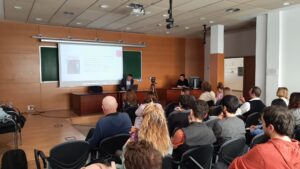 The Center of Studies on Democracies and Dictatorships (CEDID) of the Universitat Autònoma de Barcelona (UAB) organised a seminar on 24 November 2023 linked with the research of the Work Package 3 that study the historical roots and circulations of extremist narratives. Moderated by Steven Forti (UAB), leader of the ARENAS WP3, the seminar, entitled Inside Extremist Narratives, featured presentations by consortium members representing four partners within the ARENAS project.
The Center of Studies on Democracies and Dictatorships (CEDID) of the Universitat Autònoma de Barcelona (UAB) organised a seminar on 24 November 2023 linked with the research of the Work Package 3 that study the historical roots and circulations of extremist narratives. Moderated by Steven Forti (UAB), leader of the ARENAS WP3, the seminar, entitled Inside Extremist Narratives, featured presentations by consortium members representing four partners within the ARENAS project.
The afternoon session began with a presentation by Ana Yara Postigo Fuentes of the Heinrich Heine University in Düsseldorf. Her paper, entitled Defining Extremist Narratives, was the focus of discussion and it’s linked with the work done by ARENAS WP2. The seminar delved into the complex reality of extremist narratives, focusing not only on the narrative contexts of events that blur the lines between reality and fiction. These narratives not only serve as simplified explanations for complex socio-political issues, but also propose solutions to them. Extremist narratives clearly define an in-group that is ethically superior and legitimises the defence of its interests at all costs against an out-group that is inferior and perceived as dangerous. While violence may not always be explicitly endorsed, it is seen as a legitimate last resort. These narratives use the power of storytelling to emotionally reinforce us/them dichotomies, promoting worldviews and normalising ideologies.
 The second presentation was by Simo Määttä from the University of Helsinki, entitled Theorising the Circulation of Extremist Narratives. According to his presentation, three concepts are explored in order to theorise the circulation of extremist narratives: performativity, sticky emotions and rhizome. First, drawing on Jacques Derrida’s treatment of performativity, the talk argues that much of the power of extremist narratives lies in the new interpretations that emerge when a narrative is repeated in a new context. Second, as Sara Ahmed explains, the process by which certain objects of discourse evoke more emotion than others is also a performative process. Such objects include, for example, key concepts that circulate within extremist narratives, such as identity or nation. Third, following the ideas of Gilles Deleuze and Félix Guattari, an extremist narrative can also be conceptualised as a rhizomatic assemblage. Thus, extremist narratives are composed of layers of different elements, including text, speech, images, music, etc., which allow for multiple entry and exit points and enable the survival of such narratives even in a situation where some of these elements disappear or are removed.
The second presentation was by Simo Määttä from the University of Helsinki, entitled Theorising the Circulation of Extremist Narratives. According to his presentation, three concepts are explored in order to theorise the circulation of extremist narratives: performativity, sticky emotions and rhizome. First, drawing on Jacques Derrida’s treatment of performativity, the talk argues that much of the power of extremist narratives lies in the new interpretations that emerge when a narrative is repeated in a new context. Second, as Sara Ahmed explains, the process by which certain objects of discourse evoke more emotion than others is also a performative process. Such objects include, for example, key concepts that circulate within extremist narratives, such as identity or nation. Third, following the ideas of Gilles Deleuze and Félix Guattari, an extremist narrative can also be conceptualised as a rhizomatic assemblage. Thus, extremist narratives are composed of layers of different elements, including text, speech, images, music, etc., which allow for multiple entry and exit points and enable the survival of such narratives even in a situation where some of these elements disappear or are removed.
Next, Katalin Miklóssy, also from the University of Helsinki, presented a paper on Dimensions of Circulation: Mnemonic Security. In this lecture Miklóssy addressed how security, identity and the politics of history is related to extremist narratives. According to Miklóssy, circulation needs a trigger that also affects the intensity and speed of circulation. This trigger can be for instance a breach in security, which can be real event or imagined by political elite. Security breach requires a simplified narrative, a polarizing narrative about who is the enemy and in contrast, who belongs to the community to be saved. Polarization is per se a process of a black-and-white interpretation. Under threats the Other is perceived as extreme, to be marginalized, to distance from the Self. This is the link to extremist narratives. Miklóssy discussed also the spatial and temporal dimensions of circulation.
 The last speaker at the seminar was Jure Gašparič from the Institute of Contemporary History of Ljubljana. His paper was titled Countries and Narratives or How to Kill a State. On the one hand, Gašparič showed the persistence of certain stereotypes and narratives in the media and literature regarding the Balkans presented as violent places. On the other hand, he explored a concrete case of narrative which in the Slovenian case has returned like a karst river on several occasions during the last century. The Austro-Hungarian Empire was in fact presented at the beginning of the century and in the first years of Yugoslavia’s existence as a “prison of nations”. After 1945, in socialist Yugoslavia this narrative was modified to speak of Western countries as the “prisons of capitalism”. Again, in the 1980s the narrative of the “prison of nations” was recovered, however with reference to socialist Yugoslavia. Gašparič thus underlined the persistence of stereotypes and narratives in the history of Slovenia in the last century and their use as political weapons.
The last speaker at the seminar was Jure Gašparič from the Institute of Contemporary History of Ljubljana. His paper was titled Countries and Narratives or How to Kill a State. On the one hand, Gašparič showed the persistence of certain stereotypes and narratives in the media and literature regarding the Balkans presented as violent places. On the other hand, he explored a concrete case of narrative which in the Slovenian case has returned like a karst river on several occasions during the last century. The Austro-Hungarian Empire was in fact presented at the beginning of the century and in the first years of Yugoslavia’s existence as a “prison of nations”. After 1945, in socialist Yugoslavia this narrative was modified to speak of Western countries as the “prisons of capitalism”. Again, in the 1980s the narrative of the “prison of nations” was recovered, however with reference to socialist Yugoslavia. Gašparič thus underlined the persistence of stereotypes and narratives in the history of Slovenia in the last century and their use as political weapons.
At the end of the session, a rich and interesting debate took place between all the speakers, moderated by Forti, with questions from the audience. The audience was made up mainly of bachelor students, PhD students and some researcher of the UAB, who filled the Sala de Actes to capacity, marking a remarkable success for the ARENAS seminar.

